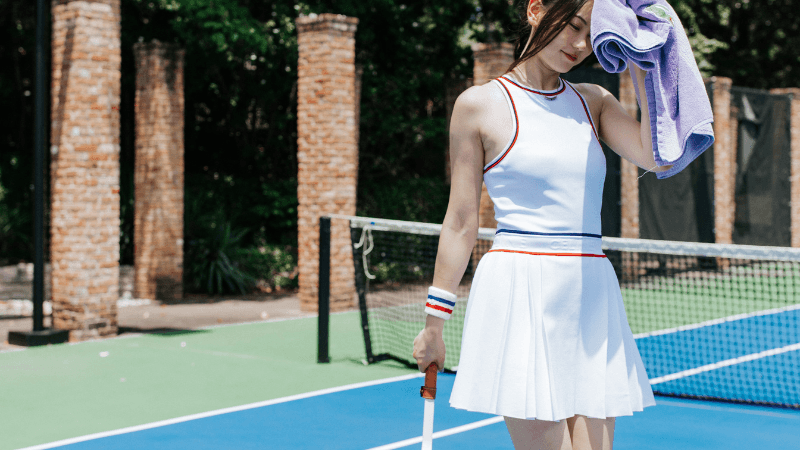The No-Show Socks Conundrum; Or, What Is Menswear Going to Do With Itself?
There was an unmistakable air of anxiety at Milan Men’s Fashion Week. How does one escape?
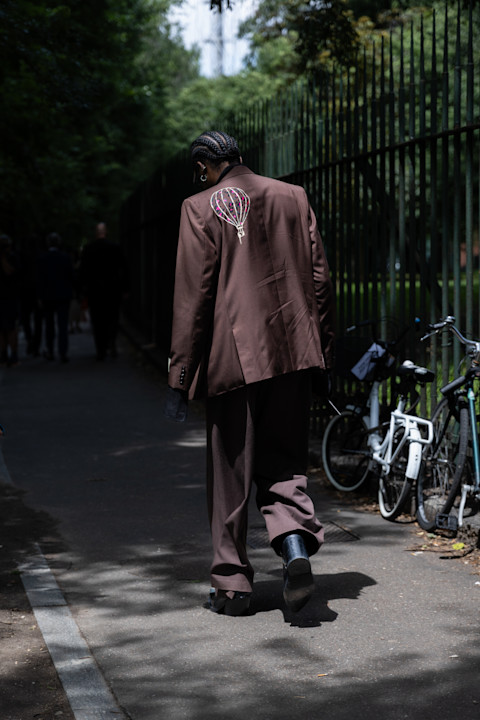
“I think he’s wearing them ironically.”
It was a sticky hot evening on the second day of Pitti Uomo at a touristy cocktail bar in the center of Florence. The fashionista in question: a 20-something man wearing no-show socks—one of the most derisive pieces of clothing in existence.The observationist: a European buyer from a rival e-commerce company. We were having something of a cross-pond cultural debate about the spritz-holding man whose no-shows peeked above a pair of light brown driving loafers, worn with khaki shorts and a salmon pink polo (the farmer’s tan goes without saying). To my eyes, this was a freshman-aged New England college student on vacation with his parents. To her, he was a shrewd industry peer, who, like us, was attending the famed menswear exhibition. The gossiping volume may have needed to come down a few decibels.“It’s definitely ironic,” she confirmed to her colleague.
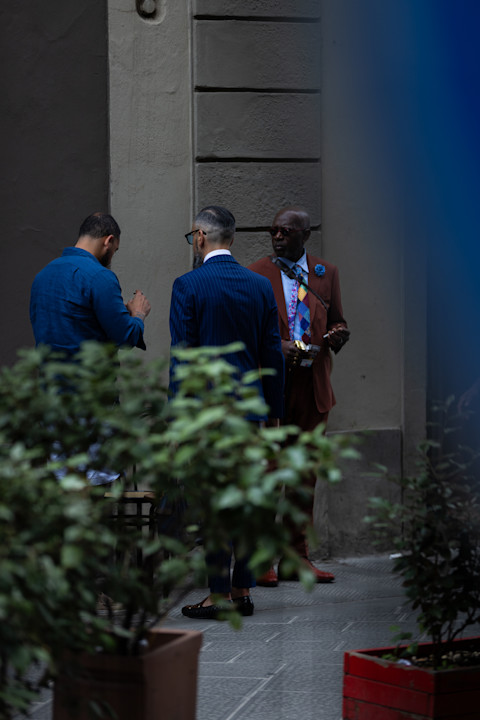
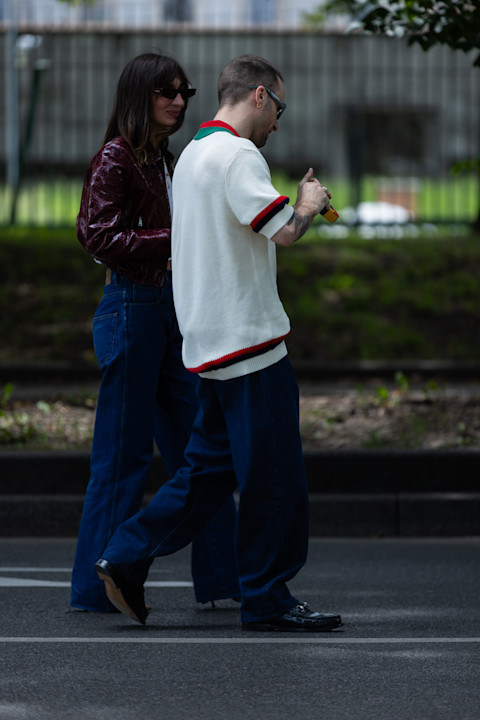
It has become increasingly common for industry folk to describe men’s fashion week as a breath of fresh air. Less pressure than the behemoth that is women’s fashion and couture weeks. For some, it offers better parties; others, the more esoteric celebrity sightings, and, when it comes to clothes, a bit more freedom for young designers to experiment. The tang of ironic dressing and the insularity of the bar conversation were the first signs that something had curdled at men’s fashion week this year.The debate, and an unneeded second round of negronis, was about to make us dangerously late to the Marine Serre show—her first proper menswear show and her first presentation held outside of her native Paris.We chose the bar for its proximity to a cab station, but it hadn’t delivered an empty cab in 15 minutes. One finally arrived, an older Italian man opened the door opposite our group, and we all entered simultaneously. Heated claims of ownership were exchanged. Surprisingly, he relented, and we instructed the driver to floor it through the winding hills outside Florence.Earlier that morning, while preparing for her show as Pitti Uomo’s guest designer, Marine Serre described the joy she experienced putting together her menswear collection. Since winning the LVMH Prize for Young Fashion Designers in 2017, she’s been navigating the hallways of European fashion’s upper echelon, but she carefully alluded to a certain relief when reflecting on the design process this time around (the show also includes women’s resort styles).Serre’s pleasure at entering the menswear fold—a version of the lightheartedness I too expected to find this week—wasn’t shared later that night at the downtown Firenze pub that had become the de facto meeting point for Pitti Uomo attendees traveling from London and New York.After a few rounds of Guinness, the niceties of industry chitchat fell away. I stumbled into a monologue from a London-based buyer who wasn’t mincing words about a buzzy new-kid-on-the-block brand.“So, what brands the cool kids in London wearing?” He looked at me like I’d asked for a mathematical explanation of gravity from inside a black hole.
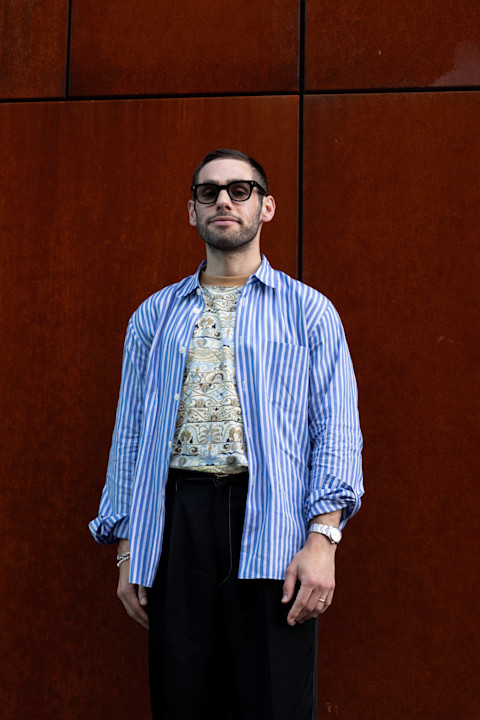
“We’re seeing various herd mentalities, people moving in packs,” says Jacob Gallagher, the men’s fashion columnist at the , explained to me later on, in Milan. “And that’s great, finding your people. But I think that creates risk in standing out from that pack.”Normally the second-fiddle event to its women’s equivalent, men’s fashion month was cresting with attention this season—and with it an uptick in scrutiny. The hottest ticket this season was an invite to Dries Van Noten. The Belgian designer’s final show is being held during Paris Men’s Fashion Week (Van Noten’s first-ever show was a menswear collection, creating bookends to his legendary career). Pharrell’s Louis Vuitton show is poised to have the same supermassive celebrity moment as his last. And, did you know Paris is also preparing for the Olympics right now? An inescapable topic of conversation, consternation, and heightened anticipation for those traveling through Florence, Milan, and ultimately Paris.Over my weeklong trip through Italy, I wondered what accounted for the pessimism in the air and conversation. Was men’s fashion week a hole-in-the-wall restaurant that had blown up on TikTok, flooded with newcomers who were displacing the locals? Or had the menswear scene become too insular for its own good?
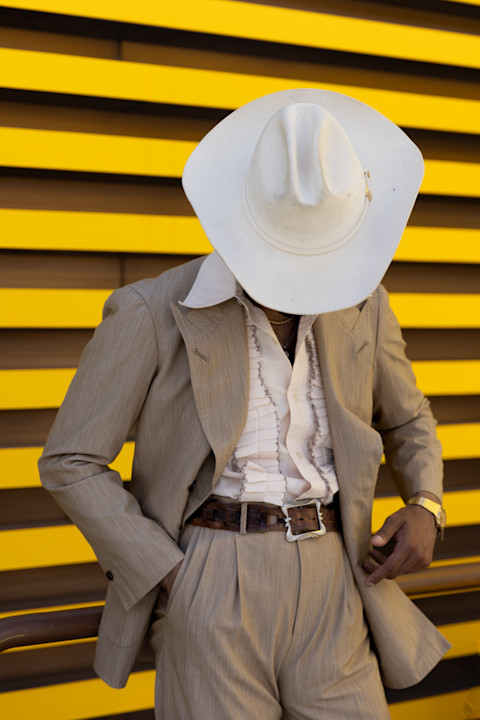
I took an Alka-Seltzer the next morning before meeting with Raffaello Napoleone, the chief executive of Pitti Immagine, the parent organization of Pitti Uomo, to make better sense of the trade show that is famous for its splattering of attendees who range from street style legends to outfit personas that would not be out of place at an American Renaissance Faire.Napoleone has been at the helm of Pitti for nearly three-and-a-half decades—a millennia in fashion years. We met in a small press room (Pitti is held annually in a 14th century fortress-turned-exhibition center) and it was clear that he’s aware of the trade show’s perception as one of the more events on the fashion calendar: anyone can buy a ticket, put on an eye-catching suit, and rub shoulders with the insiders. He was quick, however, to point out the upside in what some identify as irreverence.“We have a need to bring people together,” he explained. “Fashion has always been maybe the most sensible thermometer of social changes, the social needs.”

Dressed in a buttery cream suit and a pair of thick, black eyeglass frames, he offered hope that menswear is trending back toward tailoring as opposed to the more casual pandemic and pre-pandemic streetwear eras.“We try to put everything together, from the sheep to the shop. The whole fashion [supply] chain is based out of here and they need to be able to meet,” he said, referring to people affected by the exhibition’s success who won’t appear in social media clips or street style roundups. “This is a very important industry in Italy. We have more than 500,000 employees working. We have an official road to sustain the Italian manufacturer, in menswear especially.”As the doors closed on the Fortezza da Basso and Pitti Uomo, and the horde of buyers and reporters packed into train cars destined for Milan, the joviality once again began to fade.“Today, if you have something to say and you know how to say it well, you will find and create your own lane,” Lawrence Schlossman, one-half of the loose-lipped menswear podcast Throwing Fits, explained to me.We were chatting about the prevalence, or lack thereof, of expert menswear arbiters who can distill the madness surrounding an event like Pitti. “While democratization is a godsend, it can also lower the bar at an alarming and maybe even unsustainable clip? For a while now we have been approaching the subterranean.” I could picture the collage of outrage bait Reddit threads and snide Instagram comment replies he was referring to populating the notification feeds on both our phones.In Milan I met with Lorenzo Osti, the president of C.P. Company and son of the legendary Italian designer Massimo Osti, founder of both C.P. Company and Stone Island. He told me about his favorite piece from the new collection: a paneled GORE-TEX shell jacket that condenses neatly to be stored in a pocket or small bag. It’s the type of utility and everyday carry that satisfies the type-A fashion brain. Osti favors it for sailing.And then a small hand pulled at his trousers. It was Osti’s son, and he had the zoomies. The designer didn’t miss a beat, continuing to explain the intricacies of garment dying while entertaining his son. Lorenzo’s smile and language only grew more passionate as his son continued to spin around him—a fueling dynamic that may have paralleled his youthful self and his father’s generation-defining work.“For me personally, not being too much into fashion, I still love this gorpcore trend because it brings functionality into looks,” he said. “I’ve always been educated with this and grown the brand based off that.”For months now, identifying the post-gorpcore wave has been an infinitely repeatable conversation among menswear predictors and online commenters. The noise doesn’t phase Osti; he’ll be stuffing C.P. Company jackets into his pockets on hikes and sailboats long past any vibe shift. I thanked him for his time and let him go back to his son. Then I put a reminder in my phone to call my dad later that day (it was Father’s Day in the US, I sheepishly realized).
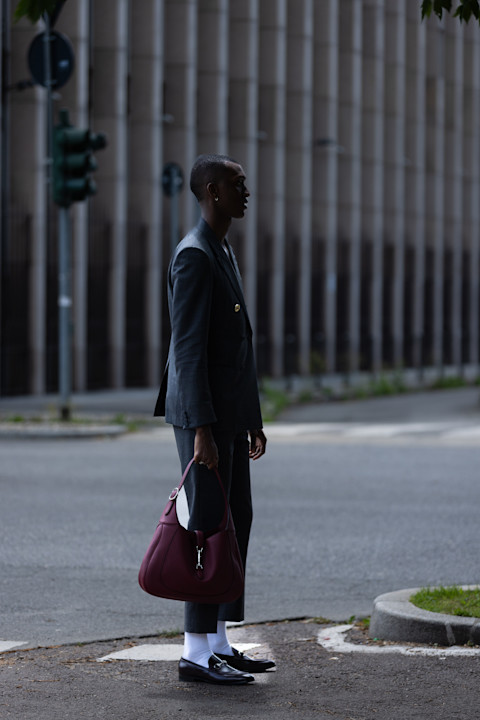
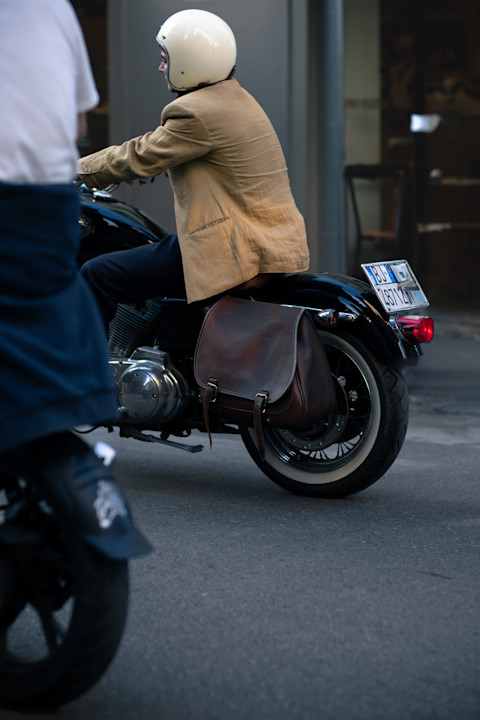
"If you had told me menswear TikTok was gonna exist, I would have gone to trade school," James Harris, the other half of Throwing Fits, declared.Harris admitted he’s complicit in the type of “bullshit narcissistic” tendencies that menswear social media thrives on. It’s a space where sincerity is synonymous with corniness and defaulting to ironic contrarianism is the quickest way to success. Finding the line between sincerity and irony is a struggle some of the more thoughtful new-media pillars like Harris are navigating.“Maybe I’ll go volunteer somewhere this weekend,” he said, punctuating his career spiral. (I stopped myself from reminding him about his obligations at Paris Fashion week during the aforementioned weekend.)At times, even the most positive discussions in the fashion space that Harris alluded to feel shrouded in insularity. When a celebrity dresses well, be sure to praise the stylist. When a brand’s social media post goes viral, direct acclaim to the marketing department. Issue praise only in conjunction with an acknowledgement of the greater powers at play, signaling that you are, in fact, too aware to be manipulated.These winding thoughts dissipated once inside Dries Van Noten’s serene Milanese showroom. For the designer’s final collection, I was given strict instructions not to take any photos or detail the garments online.He’s leaving on his terms, the associates underscored as the silver lining of Van Noten’s admittedly sad farewell; he is ending on a high note—an opportunity not often available to even the most influential designers throughout history.As we walked through the collection, the conversations between buyers and merchants were surprisingly cavalier—descriptions of an arduous hand-dying process sandwiched between jokes and references that would not be out of place in your average fashion iMessage group chat. In awe of the pieces, I found myself unconsciously fixing collars and straightening the pleat lines of garments hanging on the rack.
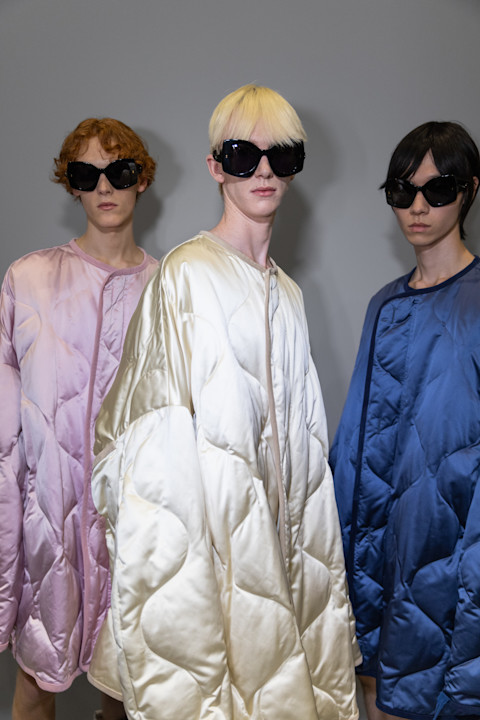
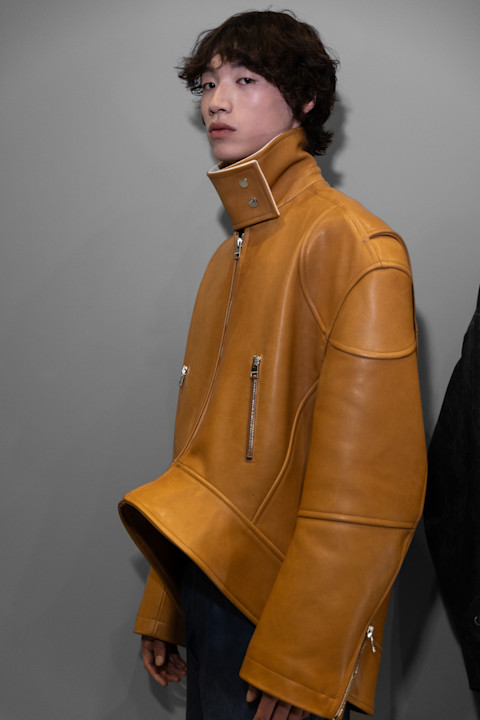
“I was at some music festivals in the last couple of months,” Jonathan Anderson told a pack of reporters after showing his eponymous brand’s latest collection later that evening. “In a weird way I wonder, has fashion become so conservative where actually what is happening out there is way more avant garde?”Throughout my conversations over the week, Anderson’s name repeatedly came up as menswear’s current top dog designer, a position spurred by both JW Anderson and Loewe’s meteoric acclaim—success the designer seems to have won through staying in touch with the masses he described after the show.“I went to a music festival and I saw more people dressing in high fashion than was actually happening fashion,” he said. “Maybe people want uniqueness, maybe they want something that challenging.”I thought back to the debate over the no-show socks. The fact that a group of menswear professionals (myself included), whose resumes would spell “expert” to the average consumer, could not agree if the look was ugly or stylishly subversive felt symbolic of the anxiety within the traveling fashion crowd. Even more telling was the fact we assumed we should be able to issue a definitive pronouncement.“A lot of menswear right now is being dictated by the street and the market,” Gallagher told me earlier in the week. “The notion of an arbiter, be it a designer or a celebrity, that’s really faded. What’s exciting to me is that people are taking from the entire spectrum of history and of clothing that they can access. There’s not a dominant trend.”


